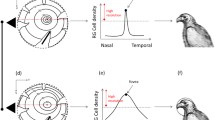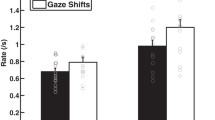Abstract
Predation can exert strong selective pressure on the evolution of behavioral and morphological traits in birds. Because predator avoidance is key to survival and birds rely heavily on visual perception, predation may have shaped avian visual systems as well. To address this question, we examined the role of visual attention in antipredator behavior in peacocks (Pavo cristatus). Peacocks were exposed to a model predator while their gaze was continuously recorded with a telemetric eye-tracker. We found that peacocks spent more time looking at and made more fixations on the predator compared to the same spatial location before the predator was revealed. The duration of fixations they directed toward conspecifics and environmental features decreased after the predator was revealed, indicating that the peacocks were rapidly scanning their environment with their eyes. Maximum eye movement amplitudes and amplitudes of consecutive saccades were similar before and after the predator was revealed. In cases where conspecifics detected the predator first, peacocks appeared to learn that danger was present by observing conspecifics’ antipredator behavior. Peacocks were faster to detect the predator when they were fixating closer to the area where the predator would eventually appear. In addition, pupil size increased after predator exposure, consistent with increased physiological arousal. These findings demonstrate that peacocks selectively direct their attention toward predatory threats and suggest that predation has influenced the evolution of visual orienting systems.






Similar content being viewed by others
References
Barbur JL, Prescott NB, Douglas RH, Jarvis JR, Wathes CM (2002) A comparative study of stimulu-specific pupil responses in domestic fowl (Gallus gallus domesticus) and the human. Vis Res 42:249–255
Bitsios P, Szabadi E, Bradshaw CM (1996) The inhibition of the papillary light reflex by the threat of an electric shock: a potential laboratory model of human anxiety. J Psychopharmacol 10:279–287
Bradley MM, Miccoli L, Escrig MA, Lang PJ (2008) The pupil as a measure of emotional arousal and autonomic activation. Psychophysiology 45:602–607
Bradshaw J (1967) Pupil size as a measure of arousal during information processing. Nature 216:515–516
Briskie JV, Martin PR, Martin TE (1999) Nest predation and the evolution of nestling begging calls. Proc R Soc Lond B 266:2153–2159
Caro T (2005) Antipredator defenses in birds and mammals. University of Chicago Press, Chicago
Charney D, Grillon C, Bremner JD (1998) Review: the neurobiological basis of anxiety and fear: circuits, mechanisms, and neurochemical interactions (part I). Neuroscientist 4:35–44
Collewijn H (1977) Eye- and head movements in freely moving rabbits. J Physiol 266:471–498
Cresswell W, Quinn JL, Whittingham MJ, Butler S (2003) Good foragers can also be good at detecting predators. Proc R Soc Lond B 270:1069–1076
Cresswell W, Butler S, Whittingham MJ, Quinn JL (2008) Very short delays prior to escape from potential predators may function efficiently as adaptive risk-assessment periods. Behaviour 146:795–813
Curio E (1978) The adaptive significance of avian mobbing: I. Teleonomic hypotheses and predictions. Z Tierpsychol 48:175–183
Devereux CL, Whittingham MJ, Fernández-Juricic E, Vickery JA, Krebs JR (2006) Predator detection and avoidance by starlings under differing scenarios of predation risk. Behav Ecol 17:303–309
Fantz R (1958) Pattern vision in young infants. Psychol Rec 8:43–47
Guillemain M, Martin GR, Fritz H (2002) Feeding methods, visual fields, and vigilance in dabbling ducks (Anatidae). Funct Ecol 16:522–529
Hadjikhani N, Hoge R, Snyder J, de Gelder B (2008) Pointing with the eyes: the role of gaze in communication danger. Brain Cogn 68:1–8
Hamada T (1984) A method for calibrating the gain of the electro-oculogram (EOG) using the optical properties of the eye. J Neurosci Methods 10:259–265
Hart NS (2001) Variations in cone photoreceptor abundance and the visual ecology of birds. J Comp Physiol A 187:685–698
Hart N (2002) Vision in the peafowl (Aves: Pavo cristatus). J Exp Biol 205:3925–3935
Kaby U, Lind J (2003) What limits predator detection in blue tits (Parus caeruleus): posture, task, orientation? Behav Ecol Sociobiol 54:534–538
Kannan R, James DA (1998) Common peafowl (Pavo cristatus). In: Polle A, Gill F (eds) The birds of North America, no. 377. Birds of North America, Philadelphia
Kiltie RA (2000) Scaling of visual acuity with body size in mammals and birds. Funct Ecol 14:226–234
LaBerge D, Brown V (1989) Theory of attentional operations in space identification. Psychol Rev 96:101–104
Lima SL, Bednekoff PA (1999) Back to the basics of antipredatory vigilance: can nonvigilant animals detect attack? Anim Behav 58:537–543
Lima SL, Dill LM (1990) Behavioural decisions made under the risk of predation: a review and prospectus. Can J Zool 68:619–640
Martin G (1986) The eye of a passeriform bird, the European starling (Sturnus vulgaris): eye movement amplitude, visual fields and schematic optics. J Comp Physiol A 159:545–557
Martin TE (1995) Avian life history evolution in relation to nest sites, nest predation, and food. Ecol Monogr 65:101–127
Martin TE, Badyaev AV (1996) Sexual dichromatism in birds: importance of nest predation and nest location for females versus males. Evolution 50:2454–2460
Maurer D (1975) Infant visual perception: methods of study. In: Cohen LB, Salapatek P (eds) Infant perception: from sensation to cognition, vol 1. Basic visual processes. Academic Press, New York, pp 1–76
McFadden SA, Reymond L (1985) A further look at the binocular visual field of the pigeon (Columba livia). Vis Res 25:1741–1746
McNamara JM, Houston AI (1992) Evolutionarily stable levels of vigilance as a function of group size. Anim Behav 43:641–658
Meyer DBC (1977) The avian eye and its adaptations. In: Crescitelli F (ed) The visual system of vertebrates, handbook of sensory physiology. Springer, New York, pp 549–612
Moore BA, Baumhardt P, Doppler M, Randolet J, Blackwell BF, DeVault TL, Loew ER, Fernández-Juricic E (2012) Oblique color vision in an open-habitat bird: spectral sensitivity, photoreceptor distribution and behavioral implications. J Exp Biol 215:3442–3452
Nagamatsu T, Kamahara J, Iko T, Tanaka N (2008) One-point calibration gaze tracking based on eyeball kinematics using stereo cameras. In: Proceedings of the 2008 symposium on eye tracking research applications. ACM, Savannah, GA, pp 95–98
Newman JA, Caraco T (1987) Foraging, predation hazard and patch use in grey squirrels. Anim Behav 35:1804–1813
Nunnally JC, Knott PD, Duchnowski A, Parker R (1967) Pupillary response as a general measure of activation. Percept Psychophys 2:149–155
Preuschoff K, ’t Hart BM, Einhäuser W (2011) Pupil dilation signals surprise: evidence for noradrenaline’s role in decision making. Front Neurosci 5:1–12
Pulliam HR (1973) On the advantages of flocking. J Theor Biol 38:419–422
Pulliam HR, Pyke GH, Caraco T (1982) The scanning behaviour of juncos: a game-theoretical approach. J Theor Biol 95:89–103
Roberts G (1996) Why individual vigilance decreases as group size increases. Anim Behav 51:1077–1086
Schleidt WM (1973) Tonic communication: continual effects of discrete signs in animal communication. J Theor Biol 42:359–386
Schneider KJ (1984) Dominance, predation, and optimal foraging in white-throated sparrow flocks. Ecology 65:1820–1827
Sherman PW (1977) Nepotism and the evolution of alarm calls. Science 197:1246–1253
Simpson HM, Hale SM (1969) Pupillary changes during a decision-making task. Percept Mot Skills 29:495–498
Szechtman H, Adler NT, Komisaruk BR (1985) Mating induces papillary dilation in female rats: role of pelvic nerve. Physiol Behav 35:295–301
Takahashi M, Hasegawa T (2008) Seasonal and diurnal use of eight different call types by Indian peafowl (Pavo cristatus). J Ethol 26:375–381
Tisdale V, Fernández-Juricic E (2009) Vigilance and predator detection vary between avian species with different visual acuity and coverage. Behav Ecol 20:936–945
Tsal Y (1983) Movement of attention across the visual field. J Exp Psychol Hum Percept Perform 9:523–530
Turk-Browne NB, Pratt J (2005) Attending to eye movements and retinal eccentricity: evidence for the activity distribution models of attention reconsidered. J Exp Psychol Hum Percept Perform 31:1061–1066
Wallman J, Letelier J-C (1993) Eye movements, head movements, and gaze stabilization in birds. In: Zeigler H, Bischof H-J (eds) Vision, brain and behavior in birds. MIT Press, Cambridge, pp 245–263
Whipple B, Ogden G, Komisaruk BR (1992) Physiological correlates of imagery-induced orgasm in women. Arch Sex Behav 21:121–133
Whittingham MJ, Butler SJ, Quinn JL, Cresswell W (2004) The effect of limited visibility on vigilance behavior and speed of predator detection: implications for the conservation of granivorous passerines. Oikos 106:377–385
Yorzinski JL, Penkunas MJ, Platt ML, Coss RC (in review) Dangerous animals capture and maintain attention in humans. Cognition
Yorzinski JL, Platt ML (2012) The difference between night and day: antipredator behavior in birds. J Ethol 30:211–218
Yorzinski JL, Patricelli GL, Babcock J, Pearson JM, Platt ML (2013) Through their eyes: selective attention in peahens during courtship. J Exp Biol 216:3035–3046
Yoss RE, Moyer NJ, Hollenhorst RW (1970) Pupil size and spontaneous papillary waves associated with alertness, drowsiness, and sleep. Neurology 20:545–554
Zeigler HP, Bischof H-J (1993) Vision, brain, and behavior in birds. MIT Press, Cambridge
Acknowledgments
We thank Gail Patricelli for helpful discussion and Jason Babcock for assistance with the eye-tracker. Peter and Martha Klopfer allowed the birds to be housed on their farm. This research was funded by a National Science Foundation graduate research fellowship, an Animal Behaviour Society Student Research Grant, the Animal Behavior Graduate Group at UC Davis, the Chapman Memorial Fund, a grant-in-aid of research from the National Academy of Sciences (administered by Sigma-Xi, The Scientific Research Society), Gail Patricelli (through UC Davis), a Philanthropic Educational Organization Scholar Award, and a National Geographic Society/Waitt Foundation grant to J.L.Y. The Alfred P. Sloan Foundation and Duke Lemur Center provided funding to M.L.P.
Author information
Authors and Affiliations
Corresponding author
Electronic supplementary material
Below is the link to the electronic supplementary material.
Supplementary material 2 (MOV 12730 kb)
Rights and permissions
About this article
Cite this article
Yorzinski, J.L., Platt, M.L. Selective attention in peacocks during predator detection. Anim Cogn 17, 767–777 (2014). https://doi.org/10.1007/s10071-013-0708-x
Received:
Revised:
Accepted:
Published:
Issue Date:
DOI: https://doi.org/10.1007/s10071-013-0708-x




